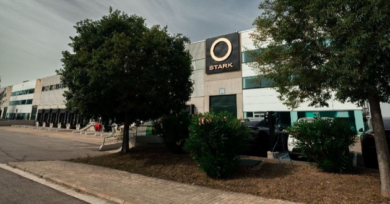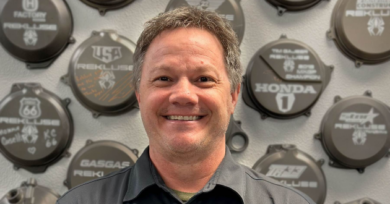Wil Garland takes reins at American Iron Horse
By Joe Delmont
Editor
Wil Garland, a long-time international Procter & Gamble executive, has grabbed the reins at American IronHorse and is now running the company. He took over as CEO on July 19.
Garland replaces John Boudreau, president, CEO and COO, who left the company unexpectedly several months ago after taking over last fall. Boudreau, a self-described hard-nosed turnaround specialist, virtually eliminated AIH’s successful marketing department and made several other changes that ruffled feathers with employees.
In a December interview with Powersports Business, Boudreau said he expected to have the Fort Worth, Texas, plant producing about 75-80 bikes per week by March, but the company did not reach that level. AIH was producing only about 60 bikes per week in June.
Garland was the winner in a national executive search to find a permanent replacement for company co-founder and CEO Bill Rucker, who split with the board of directors and left the company in May last year. Following Rucker’s departure, the company was run by James Collet and Donald Wilson, who served as co-CEOs. Wilson was a board member and Collet an advisor to AIH.
Also leaving Ironhorse recently was Tim Edmondson, the other co-founder of AIH, and the man responsible for the company’s strong bike designs. He resigned last February to develop his own custom bike venture, but continues to provide assistance to AIH. He remains a director and is the single largest individual shareholder in the company.
Garland, currently a resident of Franklin, Tenn., has a strong international business background, having spent more than a decade in Turkey, Europe and the Middle East with Procter & Gamble. One of his biggest accomplishments was turning around P&G’s Turkey operation, which lost $360 million in one five-year period. In two years, he increased sales 37% and turned a profit after eight consecutive years of losses.
“I had a great team in Turkey, a very special team,” he says. “But if you had asked anyone if (the business) could have been saved, they would have said you were crazy.” At the time he moved on, revenues there were about $475 million, and he was responsible for some two dozen P&G brands manufactured in three plants and employing nearly 1,000 people.
Garland, who came up through marketing and sales, considers himself a pretty good manufacturing guy, too, as well as being a successful teacher. “Coaching skills is a strong suit of mine,” he says. “It’s a compliment I receive most often. I always try to make time to teach people the basics of business because it strengthens your company overall.”
And, Garland says, he’s willing to face the truth in bad situations. “I’m not afraid to hear the cold, hard truth, because you can’t fix a problem that nobody knows about. You have to encourage people to share the good, the bad and the ugly. Take Enron, the worst example. (Employees) weren’t willing to come to Ken Lay until (the company) was already dead. If they would have come six months earlier, maybe they could have saved it.”
The AIH situation is similar to his other jobs, says Garland. “Just look at the internal dynamics: There’s a youthful management group that’s passionate about the business. And it’s primarily a manufacturing and marketing operation. I’ve had that in all my executive assignments.”
Riding the IronHorse
Even so, why would Garland take on the challenge of American IronHorse, a company with less than $100 million in annual sales, and one that has experienced a swinging door in the executive suite recently?
“Obviously, this was a big concern of mine,” he said during a recent interview with Powersports Business. “We went through each change and each one seemed logical and necessary. I don’t believe there is an inherent problem that is causing (the changes). I talked with the company. I talked with the board. I talked to dealers. This time, I did far more due diligence than I ever did.”
The recent CEO changes were a concern for everyone at the company, he says, from the board on down. That’s why the board took time and effort to find the right candidate, he says, interviewing more than 50 prospects.
So, why the move? “Look,” he says, “it’s better to be in the U.S. than anywhere else in the world. I wanted a company that has momentum, one that was growing. A lot of the situations I was brought into, the company was past life support; there were no prospects for growth. But IronHorse has great momentum; its a great company in a great category and it has really hot looking bikes.”
Garland said he also wanted to work with people he liked who made a good product. “I just love the product. I’ve been riding since I was eight, and I think we have the best looking bike on the road.”
Finally, he says, it’s a relief to move into a successful operation. “I didn’t want a turnaround,” says Garland. “I wanted it profitable from the getgo. I didn’t want to have to restructure and get rid of a lot of people. Our balance sheet is in great shape, there’s almost no debt.” AIH’s stock is privately-held so it does not report on its financial performance.
Next Steps at IronHorse
Garland says he wants to rebuild the AIH marketing program, which isn’t surprising, given his strong consumer products background. But demand isn’t the biggest challenge, it’s still production. “Meeting demand is any CEO’s dream challenge,” he says, adding that the situation should improve almost immediately following the recent introduction of a new production control system.
The so-called Enterprise Resources Planning (ERP) system cost more than $1 million and has been in development for nearly two years. The switch was thrown on the system last month. “Once the system says you sold three Slammers,” says Garland, “it tells you that you need this list of parts delivered within this time period in order to ship these bikes. It’ll provide a huge increase in efficiency and productivity.”
Even if ERP smooths out the production process, it won’t solve the bottleneck of an insufficient supply of frames. “We continue to work on that every day,” he says. “It’s not as bad as it was a few months ago, but it’s not where I want it to be.” After Sturgis, Garland will be meeting with his two suppliers to see if they can increase capacity to meet his needs. If not, he may add a supplier or build his own. “I wouldn’t get into the frame business myself unless I had to. But if I had to, I would do it in a heartbeat,” he says.
Garland talks with designer Edmondson almost daily and says he will continue to be involved in AIH.
“We have good chemistry. He’s a huge asset, and I’m planning on taking advantage of it. He loves the company and has assured me that he’s not walking away.” psb




